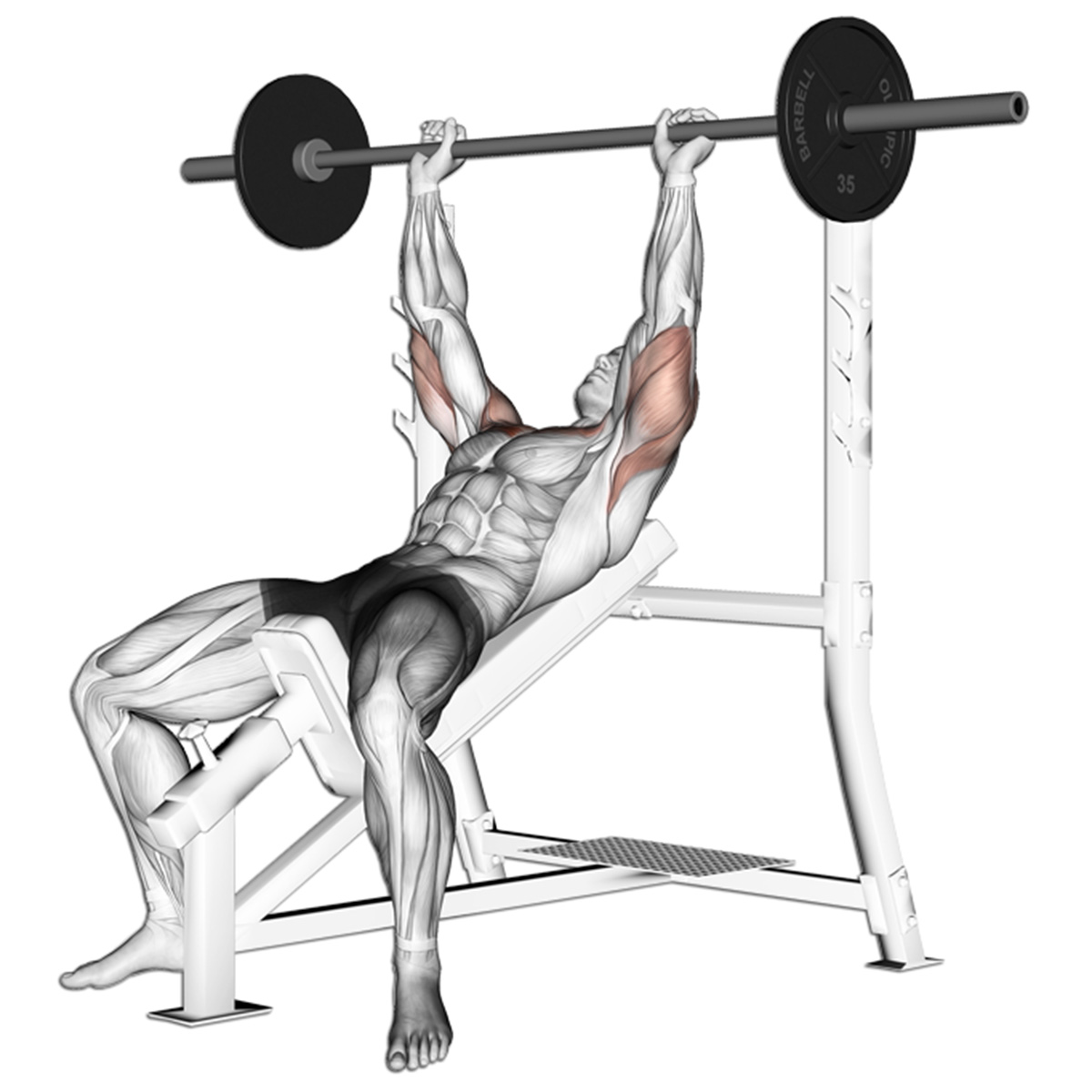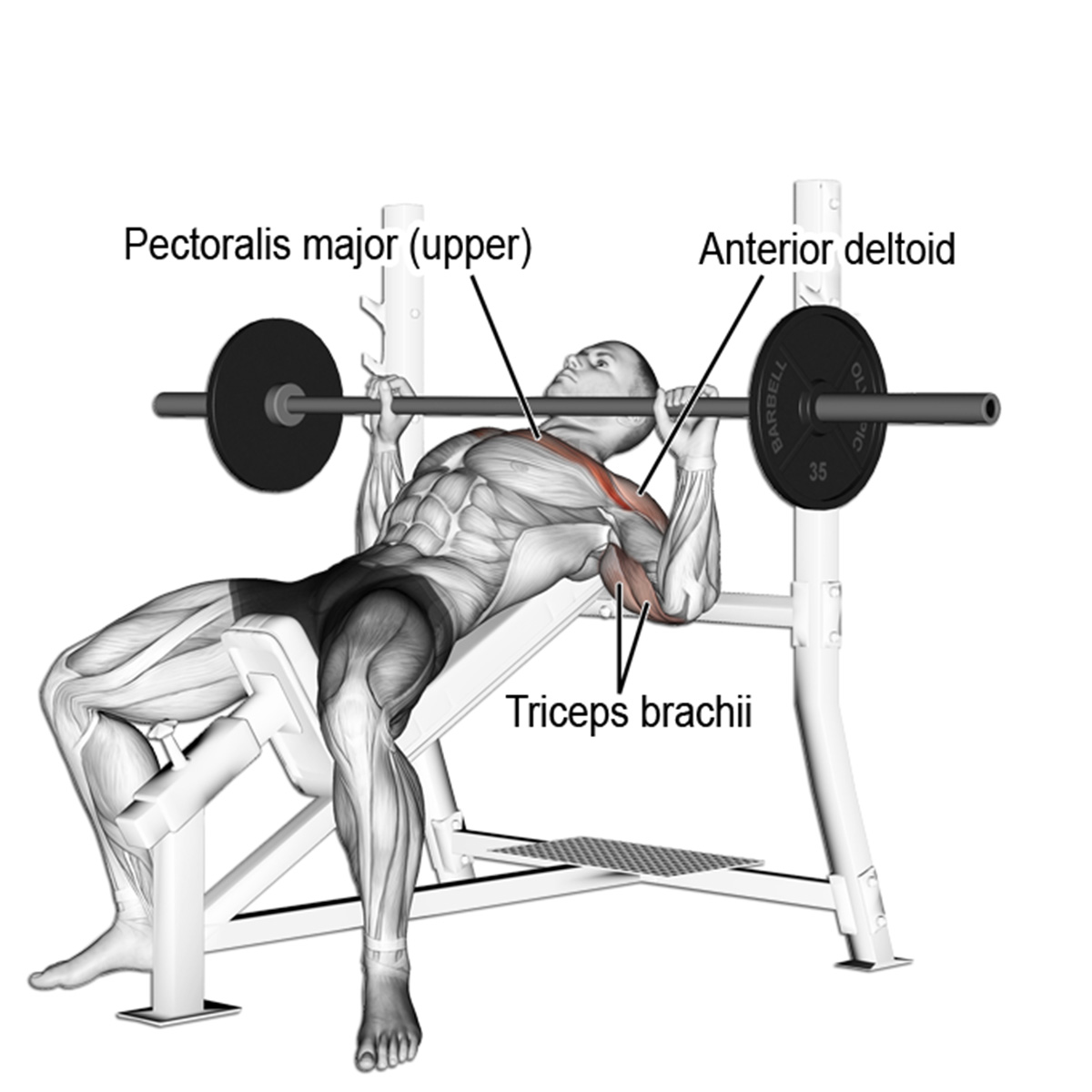Incline Bench Press
1. Positioning
The incline bench press can be a useful exercise to build the upper part of the chest if done correctly.
First thing you should be aware of is the bench position. Set your bench at an angle between 30-45 degrees (whatever is most comfortable for you). Anything higher will put more stress on the shoulders rather than your upper chest.
If you are performing this exercise on a power rack, first align the barbell so it would sit evenly on the power rack and then place the inclined bench at the centre knurling mark.
Make sure the pad is sticking past the barbell by about 15-20 cm. The reason behind this is twofold. Firstly, to make the unracking easier by getting underneath the barbell instead of hyperextending your shoulders to reach back. Secondly, to avoid hitting the J-hooks on the upward pressing movement.
For those using a Smith machine, try to place the bench in your pushing position. Because the bar path is fixed, you have to be in the right spot from the lift-off. You should be a bit further back compared to the free weight bench press.
2. Setting up
Grip the barbell so that your forearms would be parallel to each other at around a 90-degree angle. Make sure that you have the barbell set up at the right height. Having it too high might force you to hyperextend your shoulders in order to unrack while having it too low will allow you to do only half of a repetition before you even start the exercise.
Once you unrack the barbell, make sure that your glutes and back are on the bench. If you happen to arch your lower back (lumbar spine), chances are you don’t have the shoulder mobility to perform this exercise so your body has to adjust.
Alternatively, the bench angle could be too high. Try lowering it and see if that helps.
Now that you are comfortable, we can talk about form. Lowering the bar at first is going to be really awkward because your body does not have the muscle memory to perform this exercise correctly. Choose a lighter weight and focus on the technique before you move up to chucking a few plates on either side.
The bar path is quite different compared to flat bench press. You would lower the bar to the middle of the top part of your chest. Do not lower the bar into your neck. Your elbows and forearms are supposed to be in front of the barbell, feet at around shoulder width and not too far forward so that you still should have leg drive.

3. Benching
Breathe, tense yourself and start lowering the bar to your chest. Go as low as you feel comfortable. Touch the chest or stop at your comfort mark. Push the bar and, at the same time, drive your feet into the ground. You won’t slide up the bench once the bar is a bit heavier.
When you are pushing, start breathing out. Lock out your elbows, stop for a second, breathe in and start again. The reason why you are breathing in before you start benching is to tense your body so it would be easier to control the barbell. At the end of the day, you are the soft point between the bar and the bench. Repeat until you are satisfied with your form.
Keep your arms in a vertical position throughout the whole movement. It will help you to balance the bar. If you want to do a bit of variation with this exercise, you could either widen or narrow your grip. The wider you go, the more you will work the outer area of the chest. The narrower you go, the more you will involve your triceps.
Be careful when doing wide grip incline bench presses. Make sure you are not using a weight that is too heavy, as your pecs and shoulders are vulnerable.

4. Common mistakes
I normally go for incline bench press either when I am looking for an additional accessory exercise to do on my bench day or to substitute it for heavy bench days. I try not to do it in my competition preparation as I have to follow a plan. However, sometimes, even I cannot resist the temptation of the incline bench press.
But what happens when you are used to benching heavy and switch to incline bench press? If you have ever taken a few weeks off from training or haven’t done a particular exercise in a while, you know how awkward it can be to start it again.
It took me a while to understand the importance of a good form. I no longer chase big weights with exercises where I am not too comfortable with my form.
I would arch my back and try to complete the lift by any means possible. It would put an enormous amount of stress on my lumbar spine and I would do half of the lift with a help of my shoulders. After the exercise, I would walk away with a sore back and pumped-up shoulders.
Another mistake I used to make is trying to lift my legs to prevent myself from arching my back. Needless to say, it was extremely hard to balance the bar as I didn’t really have any support. Leg drive is important so make sure to utilise it right.
